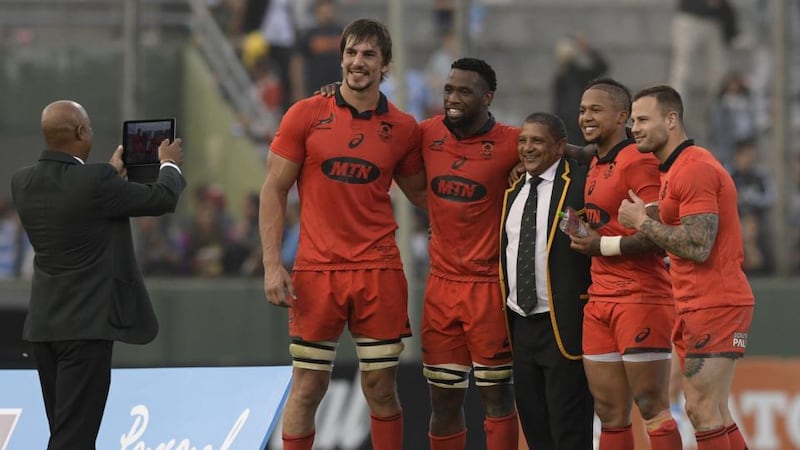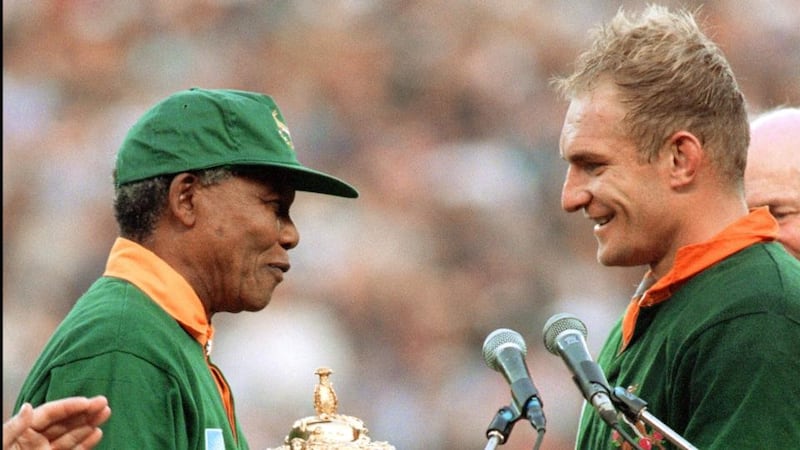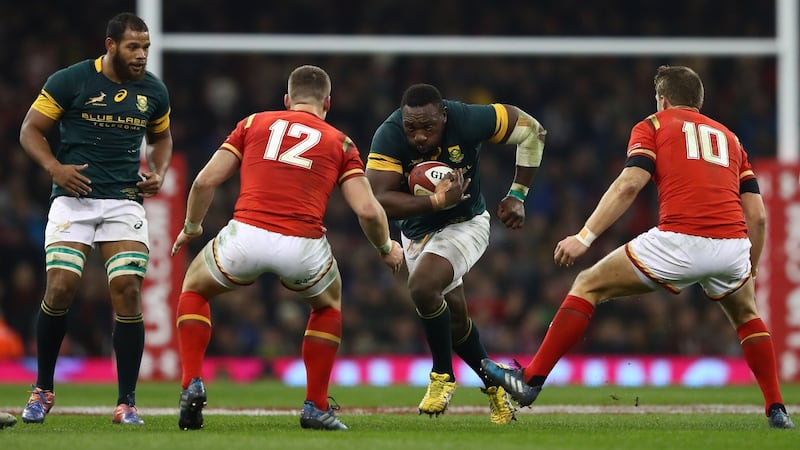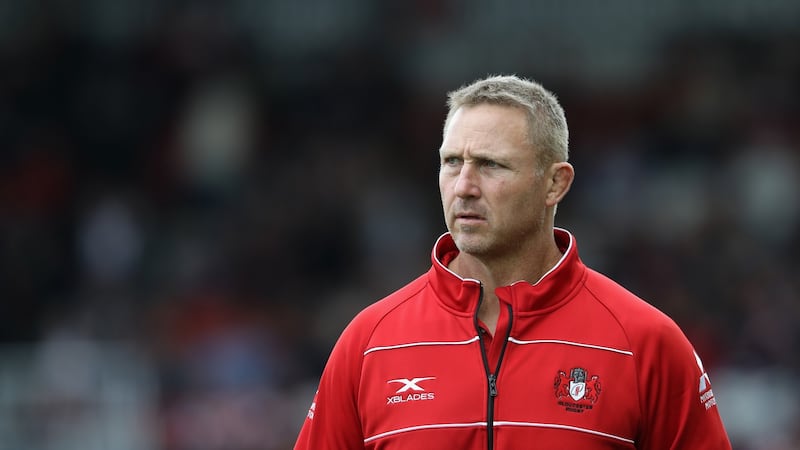Twenty-five years ago, on a sunlit winter afternoon in Johannesburg, South Africa’s isolation from world rugby ended amid the slow death of apartheid. As the all-white Springboks faced the All Blacks, Nelson Mandela had been out of prison for two and a half years. Another 20 months would pass before Mandela became president – but he already wielded real power and generosity of spirit.
Mandela argued that the South African rugby team, a bastion of apartheid for decades, should be allowed to keep their name, the Springboks, and their traditional green and gold shirts. The great man realised, even after 27 years in prison, that the country needed to shake off bitterness and prejudice. His support, though, was not universally welcomed and the political problems reflected in the prelude to that historic Test still blight rugby in a divided country today.
Issues of race and transformation dominate the backdrop to any discussion about the state of South African rugby from the grassroots to the national team. While the Springboks have experienced incredible highs since that day in 1992, their stock has fallen. The once compelling battle between the Springboks and the All Blacks has widened into a gulf. Before the whistle blew on 15 August 1992 South Africa had beaten New Zealand 20 times and lost to them on only 15 occasions. Today the record stands at a salutary 57-35 in favour of New Zealand.
When Francois Pienaar raised the World Cup at Ellis Park in 1995, the idea of South Africa losing to Japan in the 2015 tournament would have seemed impossible. Few Springbok fans could have predicted that so many of their players and coaches would ply their trade outside of, and in some cases against, South Africa. And the idea that racial divisions would still undermine rugby two decades on could only have dismayed all those who celebrated the “new South Africa”.
Yet, as the Springboks arrive in Europe for the autumn internationals, flickers of hope are tangible again. Next Wednesday, November 15th, World Rugby will vote whether to approve South Africa’s unexpected nomination as hosts of the 2023 World Cup by the tournament’s review group – which would offer South African rugby another chance to resolve its painful issues on and off the pitch.

This news for South Africa, should the recommendation be ratified, is exhilarating – particularly after the humiliating 57-0 defeat by the All Blacks two months ago. That shocking result has made leading figures in South African rugby reflect even more deeply on the difficulties already so evident on that crisp afternoon in August 1992.
Permission for the game to proceed had been granted by Mandela and the African National Congress on the condition that Die Stem, the anthem of apartheid, would not be played and the old orange, white and blue flag would not be flown. “That match caused an incredible furore,” recalls Dan Retief, the venerable South African rugby journalist. “Louis Luyt [the reviled rugby union president] insisted on playing the old anthem. Die Stem was bellowed out and the old flags waved. I went cold. I remember comparing it to a Nazi Youth rally. It showed rugby again as the game of the white right – which did not reflect the wider country.
“Danie Craven [the president of the union for decades before Luyt] had decreed we would always return against our greatest rivals. It showed our arrogance. We played New Zealand, Australia and then toured France and England. Typical South Africa! The Springboks lost narrowly to the All Blacks [27-24]but that game put rugby back in the cross hairs of government policy.”
It is intriguing to talk to two former Springboks who played in that 1992 Test. Pieter Muller, who made his debut at centre, says: “I was only 23 so playing the All Blacks was a bit scary – and hearing the anthem gave me mixed feelings. On the one side you wanted to sing your anthem but at the same time you knew the difficulties. But you saw the pride of people crying as they sang. So it was quite emotional and 80,000 people at the old Ellis Park carried us.”
Naas Botha, the Springboks captain and talisman with his huge boot, was 34. He had featured on the violent tour of New Zealand in 1981 when anti-apartheid protesters clashed with the police. Botha, now a straight-talking pundit, says: “I was never one of those that got involved in politics. Yes, we had that incident with the anthem but if you look back at what we achieved in the last 25 years it actually worked out quite nicely.”
It is true that South Africa have won two World Cups since isolation ended and, under Nick Mallett’s coaching, they set a then world-record-equalling run of 17 consecutive Test victories in 1998. Yet those days of dominance are long gone – last year they were beaten by Italy for the first time – and, in any case, the challenges of South African rugby are inherently political.
Fleeting ecstasy
Even the sweetness of South Africa’s greatest rugby triumph, winning the 1995 World Cup, was political in nature. The images of reconciliation, sealed by Mandela wearing a Springbok shirt as he celebrated victory over New Zealand in the final, were matched by the fleeting ecstasy of the “rainbow nation”. “The World Cup united the nation and there were remarkable scenes of black taxi drivers dancing with white supporters,” Mallett agrees, “but I remember thinking: ‘This is not the reality of South Africa.’ The next day the privileged and wealthy went back to the suburbs and the poor and the unemployed returned to their areas. So it masked the problems we faced later.”
The 1995 Springboks team included Chester Williams. A “coloured” man (a word still used in post-apartheid South Africa to describe people of mixed ancestry), Williams was a dynamic wing who made the team on merit. But five years later Mallett knew he had to push transformation – in answer to government pressure and also because it was important to open up opportunities. He selected Owen Nkumane as the first black African to play for the Springboks when South Africa toured Britain and Ireland in 1998.
Nkumane played a few midweek games and looked below the requisite standard. His playing career faded into obscurity and he made the equally difficult transition as a black man into the white world of the South African rugby media where he is now a popular commentator and interviewer.
His selection had been booed by white fans but Nkumane saw the wider picture. “I was surprised to be picked,” he says, “but a group of us had played for SA Under-20s. We were just on tour for experience but it was still a proud moment. I remember walking along a London street and a South African stopped me and said: ‘You’re doing this for all of us.’ That hit home.”

Issues of integration continued. Thando Manana became the third black Springbok two years later and made headline news when, in contrast to Nkumane, he refused initiation rituals which, he believed, epitomised Afrikanerdom. On tour in Argentina he would not accept being caned with a snooker cue or drinking a concoction which included sweat squeezed from socks worn by his fellow Springboks. Manana pointed out that, as a Xhosa, he had been initiated into manhood.
“I come from the Eastern Cape, the cradle of black rugby,” Manana says, “and I’m very comfortable with the colour of my skin and I love my culture. Nick Mallett had stopped the initiations but after he was fired it came back. I stood my ground. I was not going to belittle myself. It was the first time someone had refused and it made worldwide news. But I was right to resist. To reconcile our cultures it was important we respected each other. If they took a stick and thrashed my buttocks until I couldn’t walk would this make me proud to be a Springbok? Of course not. It was a barbaric act and I preferred to call for unity and racial reconciliation.”
Manana was certain his career suffered because of his refusal to submit. “Definitely. We were made to feel as if we were inferior. Yet we are not.”
His new book, Being A Black Springbok, captures the passion for rugby among many black South Africans. Despite government insistence that at least half of the Springbok squad at the 2019 World Cup should be black and coloured players, Manana argues that not enough is being done to instil change at all levels.
“You have to embrace transformation across the board. Craven Week showcases the best schoolboy rugby and not once has the tournament been played in a black township. This year it was held at one of the top white private schools even though 50% of the players were black. Surely the administrators can do more to make sure rugby gets a new audience?
“It starts with change in our hearts and minds. In the current Springboks setup you have black players sitting in one corner, white guys in another corner. We need them sitting together under an umbrella of unity.”
Manana believes that unless there is a cultural shift, and the old racial divide is obliterated from the grassroots, black players will often still be regarded as quota figures. “Definitely,” Manana says, while acknowledging the exceptions. Bryan Habana, the leading try-scorer in Springbok history with 67 tries in 124 Tests, is a superstar while Tendai Mtawarira, the loosehead prop, is a cult figure after 95 Tests.
As a journalist Retief opposed apartheid but, as he underlines now, racial sensitivities mean an objective critique is not always possible. “People deny the quota system still exists but it obviously remains. And if you criticise a black or coloured player it’s seen as racism and you get crucified on social media. But I don’t know how else we could have done it because we had to find a way to bring in black players. It’s just sad it’s endured for 25 years. Our coaches can’t pick an ordinary team. They have to take cognisance of the fact we need a racial quota because we were the country of apartheid, the most appalling form of racism. We’re still trying to fix it.”

The challenge has been divisive. Mallett is now the leading rugby analyst on South African television and he recognises the shared disaffection. “Transformation has caused anger and disappointment in the Afrikaans community because they feel many of their players are passed over and have to go overseas. And lots of black and coloured guys feel: ‘Hang on, we’re not always getting the chance to show our ability in positions where we’re as good as you.’ We have made progress and we’ve got many more black and coloured guys playing Super Rugby. But not at lock or tighthead prop. These are positions where the difference between the best white and black player is vast.”
He still believes the government aim of reaching 50% black and coloured players in the Test side by 2019 is manageable – even if no other team in world rugby faces such a challenge. “Ideally we would like to just pick the best players but transformation is part of South Africa and it is possible to get close to that 50% mark even now. But the coaches and selectors haven’t used their brains. We even picked a white scrum-half, Francois Hougaard, on the wing – as Allister Coetzee [the Springboks’ coloured head coach] did last year. It was a poor decision because we have some great black wingers. It was a real slap in the face of any competitive black player. And when you look at full-back we have three players, Dillyn Leyds, Warrick Gelant and Andries Coetzee, who is holding the position down. They are of similar ability. My view is you must give the opportunity to the black player [Gelant or Leyds] because you’re not going to weaken the side.
“If we look at full-back, both wings, outside-centre, where Lionel Mapoe is very good, the back four positions could be occupied by really strong and skilful black players. We have Elton Jantjies at 10 and Beast Mtawarira is doing a great job up front. Six out of 15 is not a disaster in transformation terms. You’re really only looking for one more player to virtually get the 50% for 2019. But the Hougaard decision was insensitive and shows a lack of understanding of transformation.”
The targets for transformation have caused ructions. In 2015, the buildup to the World Cup was disrupted when the Congress of South African Trade Unions (Cosatu) called for the then coach Heyneke Meyer to be sacked over the lack of selection of black players when only Habana and Mtawarira were picked in a match-day XV. And for all the possibilities offered should they win the 2023 bid, it was only allowed to go ahead when a ban on the South African Rugby Union applying to host tournaments for failing to reach transformation targets was lifted weeks before the deadline to apply.
Botha laments the way in which transformation is used to excuse the Springboks’ decline rather than focusing on the diminished skill levels in South African rugby. “I never had any complaints regarding the way forward. It’s the new South Africa and for rugby to grow you must involve everybody. I just get fed up with people saying the quota system is the problem. Absolute nonsense. We are not losing because of quotas. We lose because we’re not playing well. I watched the semi-finals of Currie Cup [the provincial competition] and half the guys couldn’t even catch the ball.”
White players and coaches are still being lured to the northern hemisphere or Japan – as the ailing rand cannot compete with the euro, pound and yen. There is now a consensus within South African rugby that the country’s best coach is working for Gloucester. In four years with the Lions in Johannesburg, Johan Ackermann transformed a ramshackle outfit into a thrilling team. The Lions contested the last two Super Rugby finals and Ackermann’s work should have ensured the South African Rugby Union offered him a contract. Mallett even advised the union that Ackermann and his assistant Swys de Bruin should work with Coetzee and, after the 2019 World Cup, they could take charge. Such continuity would replicate New Zealand’s long-term planning.
In Gloucester, on a cold midweek evening, the fiery debates of South African rugby crackle from a 6,000-mile distance. Ackermann also admits his tangled feelings when moving to England. “There were mixed emotions for me, my family and people that support me. And I’m not deaf. You hear people saying it’s sad to lose me. But other people are right to say if I improve my coaching ability through this new experience then we can all benefit. I was very emotional leaving the Lions, because I had such a bond with everyone. I could have hung on another year as I had a contract and hopefully third time lucky we could have won the Super Rugby title. But it was time for a change.”

Did the union talk to him about possibly becoming the Springboks coach after Coetzee? “No. I was grateful they gave me an opportunity with South Africa A. But there were no talks about the process beyond 2019. I can only make decisions on the now so it was either Lions or Gloucester. It wasn’t like they gave me any option and said: ‘We’d like you involved in some capacity and after four years we’ll reassess.’ Look at the All Blacks. Steve Hansen was assistant for eight years before becoming head coach. He’s looking good for [LASTING]12 years. I would put money on their next coach being his assistant, Ian Foster. So it would have been nice if the South African union saw me as someone that could be involved. But I can’t force it.”
Apart from the draining of players and coaches, Muller believes: “We’ve failed on many levels. Management and administration have been a mess. In 2008 I was part of an organisation called SA Rugby Legends and we coached on the [impoverished, coloured] Cape Flats for five years. About 20 schools had played rugby on the Cape Flats before isolation ended in 1992 and when we started there were no more than three schools playing. We revived the game because we helped coloured schools play in national tournaments. We developed that whole programme and I am glad the union then built on our foundation. There are now 20,000 kids playing on the Cape Flats.”
Identity
Manana is more concerned that the identity of the coaches for next year’s Super Rugby teams reflects the old pattern. “The Lions will be coached by Swys de Bruin – a white man. The Stormers will be coached by Robbie Fleck – a white man. The Sharks will be coached by Robert du Preez – a white man. The Bulls will be coached by John Mitchell – a white man. There are no black assistants. Where are the black people? Nowhere to be found.”
Deep structural problems remain. There are not enough professional players to sustain the 14 unions, each of whom has an equal vote, and moves are under way to shrink the structure to eight or nine provinces. But the smaller unions are unlikely to vote themselves out of existence. At the same time changes to Super Rugby mean the Cheetahs and Southern Kings, from the rugby heartlands of Bloemfontein and Port Elizabeth, are now forced to play in the Pro14 against Irish, Scottish, Welsh and Italian teams. Against a fractured backdrop it was not surprising the Springboks should be struggling.
After the 57-0 embarrassment Mallett said: “Criticising this Bok team is like clubbing a baby seal. Up until the 57-0 defeat we’d actually had quite a good 2017. We had a very inexperienced captain [EBEN ETZEBETH]and we also saw the coaches’ inexperience. They didn’t have an idea what to do when put under such pressure by a quality side.”
For Retief: “In all my years following rugby that was the worst day. Poor old Allister Coetzee said he saw some positives but it was horrific. We then played New Zealand again in Cape Town and everyone was celebrating because we performed with such gumption [South Africa lost, agonisingly, 25-24 ]. I’ve been writing about rugby since 1970 and it used to be absolutely foreign for a South African supporter to be happy in defeat. But it showed we can still play hard, uncompromising rugby where our forwards dominate. We have been trying to be more expansive but we’ve sacrificed the lineout and scrum – where we are traditionally strong.”
Mallett was encouraged but he stresses that “South Africans always lift themselves for a one-off ferocious game. New Zealand can play at a high level much more consistently because of their coaching and leadership. We require a do-or-die scenario to replicate that intensity.”
This Saturday the Springboks start their last road trip of the year in Dublin. After Ireland they play France, Italy and Wales. “I don’t have trepidation,” Mallett says. “It’s just a shame we’ve got Ireland, the hardest game, first. But French rugby is not great and we’ve beaten them this year. We should beat Italy by doing the basics. Winning against Wales is really possible. Three wins out of four would be satisfactory. If we get four out of four we will have turned the corner.”
There will be more spice to the first two games because Ireland and France are smarting from the likely loss of hosting the 2023 World Cup. “South Africa is in dire need of positive news politically and economically,” Mallett says. “So this is a huge stimulus. We had an outstanding bid and the presence of Cyril Ramaphosa [the deputy president] and our minister of sport, Thulas Nxesi, confirmed strong government support.”
Whenever I have spoken to Manana he seems consumed with workshops or meetings to restructure the game. During our first interview two weeks ago Manana seemed pessimistic that there would be significant change within South African rugby over the next 10 years. But, now, his rekindled optimism around the 2023 World Cup feels profound and allows us to look ahead rather than back to the wounded past.
“Fortune favours the brave,” he says exuberantly. “For me it shows evidence of our fighting spirit and the fact we can still draw inspiration from Nelson Mandela. I believe South Africa has the persistence and determination to host a World Cup of real magnitude. If we get it then the real test will be if this World Cup can unify rugby in a lasting way. So winning the bid is only a foundation. The premise should be to host a wonderful World Cup but, also, to heal the game in South Africa and make it accessible to all.”
Over the past weeks there have been times when my head, even as a South African, has felt ready to burst with the contrasting arguments. It is sad to still play the colouring-by-numbers game 25 years after isolation – but South Africa’s 34-man squad on their current tour includes 15 black and coloured players. This Saturday, on a probably raw and dark Irish autumn afternoon, these young South Africans of different colours will link arms to sing their revised national anthem in five languages – Xhosa, Zulu, Sesotho, Afrikaans and English. It is a hybrid anthem but, also, one of the most beautiful national songs. New hope for South African rugby will echo again.
(Guardian service)













